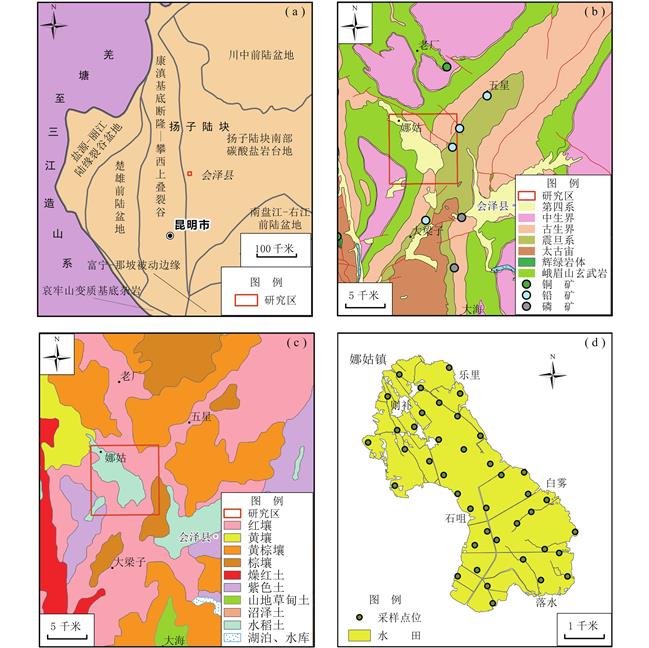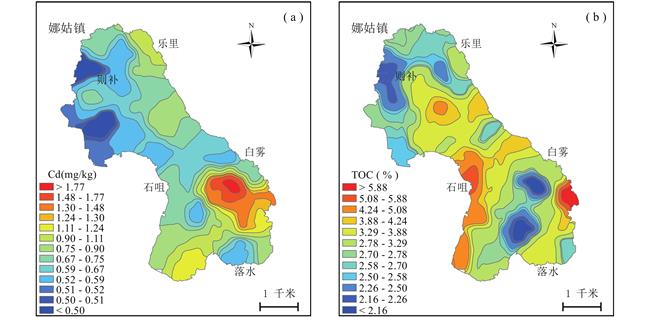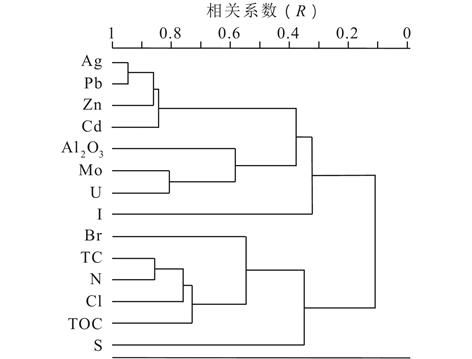| 重金属高背景区水稻镉积累与健康安全风险评价:以云南省会泽县娜姑镇为例 |
| |
| 引用本文: | 刘才泽, 陈敏华, 雷风华, 黄勇, 王雪莲, 王君, 邓国仕, 张越. 2024. 重金属高背景区水稻镉积累与健康安全风险评价:以云南省会泽县娜姑镇为例. 沉积与特提斯地质, 44(1): 194-204. doi: 10.19826/j.cnki.1009-3850.2022.11002 |
| |
| 作者姓名: | 刘才泽 陈敏华 雷风华 黄勇 王雪莲 王君 邓国仕 张越 |
| |
| 作者单位: | 1.中国地质调查局成都地质调查中心(西南地质科技创新中心),四川 成都 610218;2.自然资源部成都矿产资源监督检测中心,四川 成都 610081;3.浙江大学环境与资源学院,浙江 杭州 310085 |
| |
| 基金项目: | 中国地质调查局地质调查项目(DD20230555,DD20221733,DD20201125,DD20190524) |
| |
| 摘 要: | 
调查发现,重金属高背景区存在土壤中的镉含量超标,而农作物中的镉含量并未超标的现象,但对其原因知之甚少。开展区内农作物镉积累研究并探寻制约农作物镉吸收的因素,对土壤环境质量评价和污染土地生态修复都具有重要意义。以云南省会泽县娜姑镇娜姑坝子为研究区,采集了水稻籽实和配套土壤样品各41件,采用ICP-MS方法检测了Cd含量。通过偏相关、R型聚类、逐步线性回归等分析了水稻镉与土壤元素(指标)之间的相关关系。结果显示,水田土壤镉(Cd)含量为 0.467~1.87 mg/kg,平均为 0.78 mg/kg,是全国土壤背景值的 5.69 倍,58.5% 的样品超过农用地土壤污染风险筛选值。水稻(糙米)镉含量为 0.007~0.062 mg/kg,平均 0.016 mg/kg,均低于食品安全国家标准限值。
水稻镉与土壤铀(U)、钼(Mo)等呈显著正相关,与土壤有机碳(TOC)、硫(S)等呈显著负相关,与土壤 Cd 总量和酸碱度(pH)无显著相关性。土壤镉超标而水稻镉不超标的现象可能与土壤富含有机碳有关,该地区土壤有机碳(TOC)含量达全国背景值的5.57倍。当 TOC > 3% 时,水稻镉含量迅速下降。据此提出土壤镉环境等级的有机碳修正方法,将研究区3.42 km2(5129 亩)Ⅱ等水田修正为Ⅰ等。此外,还提出了一些土壤养护和修复的建议。

|
| 关 键 词: | 镉 土壤-水稻系统 土壤有机碳 重金属高背景 云南会泽 |
| 收稿时间: | 2022-06-06 |
| 修稿时间: | 2022-09-19 |
|
| 点击此处可从《沉积与特提斯地质》浏览原始摘要信息 |
|
点击此处可从《沉积与特提斯地质》下载免费的PDF全文 |
|



